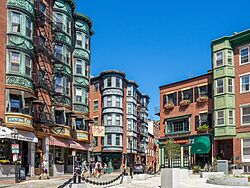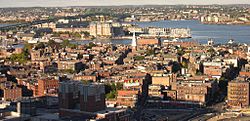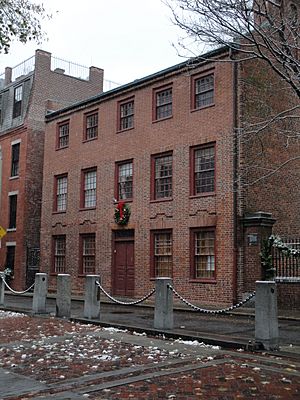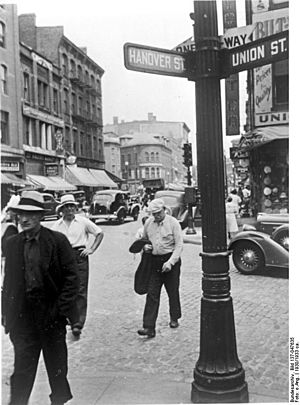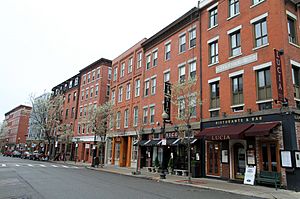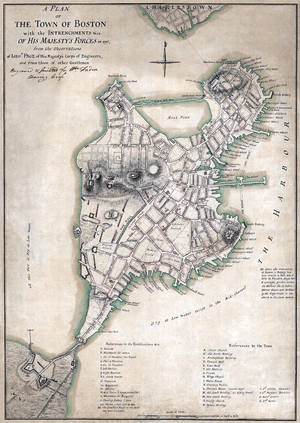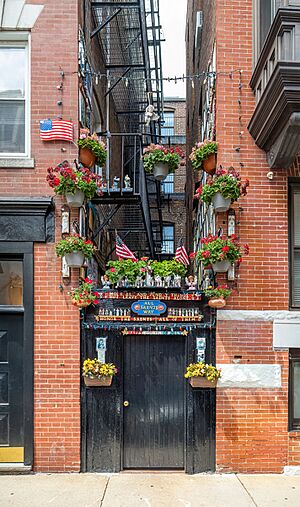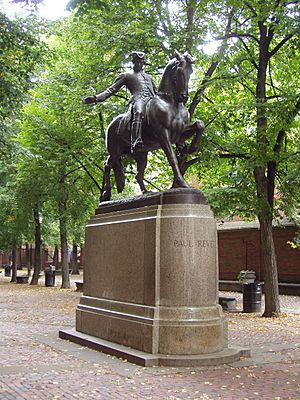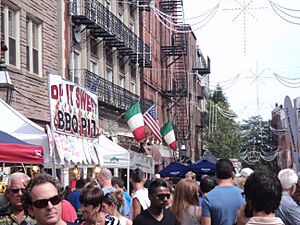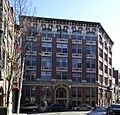North End, Boston facts for kids
The North End is a historic neighborhood in Boston, Massachusetts, United States. It's Boston's oldest community, with people living there since the 1630s! Even though it's quite small, about 0.36 square miles (0.93 km2), it has many shops, restaurants, and fun places to visit. The North End is especially famous for its large Italian American population and its delicious Italian food.
Quick facts for kids
North End
|
|
|---|---|
|
Aerial view of the North End
|
|
| Country | United States |
| State | Massachusetts |
| County | Suffolk |
| Neighborhood of | Boston |
| Area | |
| • Total | 0.366 sq mi (0.95 km2) |
| Elevation | 27 ft (8 m) |
| Population
(2010)
|
10,131 |
| • Density | 27,680.4/sq mi (10,687.5/km2) |
| Time zone | UTC-5 (Eastern) |
| ZIP Code |
02109, 02110, 02113
|
| Area code(s) | 617 / 857 |
| GNIS feature ID | 607004 |
Contents
History of the North End
Early Days: 1600s
The North End became a clear community in Boston around 1646. Just three years later, it had enough people for its own church, called the North Meeting House. This church helped create North Square, which became the heart of the community.
A very important minister named Increase Mather lived here and attracted many people. His home and the church were destroyed by a fire in 1676, but the church was quickly rebuilt. The famous Paul Revere House was later built where Mather's home once stood. Part of Copp's Hill became a cemetery, now known as Copp's Hill Burying Ground, with graves dating back to 1661.
Growing Community: 1700s
In the 1700s, the North End was a popular place to live. Rich families lived alongside skilled workers, laborers, and servants. You can still see two brick houses from this time: the Pierce-Hichborn House and the Ebenezer Clough House. The Old North Church, Boston's oldest church building, was also built then.
During the early days of the American Revolution, people protested the Stamp Act. In 1765, rioters attacked the home of Lieutenant Governor Thomas Hutchinson in North Square. In 1770, a young boy named Christopher Seider was accidentally shot during a protest on Hanover Street.
Later, during the Siege of Boston, the British took apart the North Meeting House to use its wood for fires.
Changes and New Arrivals: 1800s
The early 1800s saw a lot of business growth in the North End, especially on Commercial, Fulton, and Lewis Streets. However, by the late 1840s, living conditions became very crowded. Many immigrants came to Boston and settled here, starting with the Irish, then Eastern European Jews, and later Italians. Wealthy residents moved to newer areas like Beacon Hill.
In 1849, a serious illness spread through Boston, hitting the North End the hardest. Many people in the North End got sick. In 1859, there were disagreements between the Irish Catholic immigrants and the existing Protestant community. By 1880, most Protestant churches had left the neighborhood.
Later in the 1800s, many groups formed to help the poorer residents. The North Bennet Street Industrial School was founded to teach skills for jobs. People also started replacing old wooden houses with new brick apartment buildings, many of which are still standing. The city also helped by building parks and playgrounds like the North End Park and Beach.
Modern Times: 1900s to Today
In the early 1900s, the North End was home to many Jewish and Italian immigrants. Businesses like the Prince Macaroni Company started here. The city also improved public places, building the Christopher Columbus School, a public bathhouse, and a library. The Paul Revere Mall (also called the Prado) was also created, helping to modernize the area.
In 1918, a severe flu outbreak affected the crowded North End. So many children lost their parents that a special home was created for them. In 1919, a huge molasses tank exploded, causing the Great Molasses Flood. A 25-foot wave of molasses rushed down Commercial Street, killing 21 people and injuring 150. It caused a lot of damage.
In 1934, the Sumner Tunnel was built, connecting the North End to East Boston, where the airport is. In the 1950s, the John F. Fitzgerald Expressway (Central Artery) was built to help with traffic. This highway separated the North End from downtown Boston. A second tunnel, the Callahan Tunnel, opened in 1961. Even with the construction, the North End was known for being a lively and friendly place.
Through the 1960s and 1970s, some people moved out of the North End, and some shops closed. However, residents worked to build affordable homes, especially for older people.
In 1976, President Ford and Queen Elizabeth II visited the North End as part of the United States Bicentennial celebrations.
From the late 1900s to the early 2000s, the Central Artery highway was taken down and replaced by the Big Dig project. This made it hard to get to the North End for a while, causing some businesses to close. Now, the beautiful Rose Kennedy Greenway is where the old highway used to be.
Geography of the North End
The North End is located on what was once the Shawmut Peninsula. Over many years, land was added to the area, changing its shape. Copp's Hill is the biggest natural feature in the neighborhood.
Today, the North End is next to the Rose Fitzgerald Kennedy Greenway. The Charles River and Mystic River are to the north, and Boston Harbor is to the east. Nearby neighborhoods include Government Center and Quincy Market. Bridges and tunnels connect the North End to Charlestown and East Boston.
Commercial Street and Atlantic Avenue run along the harbor side. Hanover Street is the main street that goes through the middle of the neighborhood. The North End Parks, part of the Greenway, are where the old elevated highway used to be. Other green spaces include Cutillo Park, Langone Park, and the Christopher Columbus Waterfront Park.
There isn't a subway station directly in the North End, but you can walk 5-10 minutes to stations like Aquarium, Haymarket, and North Station for the Blue, Orange, and Green subway lines.
People and Communities
In 2010, about 10,131 people lived in the North End. Most residents are White (90.88%), with smaller groups of Hispanic or Latino, Asian, and Black/African American people.
African American Community
From the 1600s to the 1800s, a small community of free African Americans lived near Copp's Hill. Some of their gravestones can still be seen in the Copp's Hill Burying Ground. By the late 1800s, many had moved to Beacon Hill.
Irish Community
Between 1845 and 1853, many Irish immigrants came to the North End, making it mostly Irish. By the late 1800s, the North End was almost entirely Irish or Irish-American and Catholic.
Jewish Community
A Jewish community started to grow in the North End in the late 1800s, mainly along Salem Street. They built places of worship and schools. However, by 1922, most Jewish residents had moved to other neighborhoods like Roxbury.
Italian Community
By 1890, the North Square area was known as Little Italy. The number of Italian immigrants grew a lot, reaching its highest point in 1930 with 44,000 people. Today, many businesses and events celebrate the neighborhood's Italian roots, but the North End is becoming more diverse. In 2014, about 11% of the population was born in Italy, and another 38% had Italian heritage.
In 1923, the Michelangelo School was built and named to honor the Italian residents. The street it was on was also renamed Michelangelo Street.
Italian bakeries, restaurants, and shops opened in the early 1900s. Many immigrants found jobs selling food or in construction. Some businesses started here, like Prince Pasta and Pastene Corporation, still exist today.
The Italian-American community faced some challenges, but after World War II, they gained more political power. Today, the North End's "old world" Italian feel attracts many tourists, and its streets are full of restaurants. Italian festivals, like the Feast of St. Anthony, are still celebrated and bring in large crowds.
Arts and Culture

Arts and Entertainment
The North End Music and Performing Arts Center (NEMPAC) and the Improv Asylum Theater are located on Hanover Street. All Saints Way, a unique private art project on Battery Street, sometimes opens to the public. It features framed pictures of Catholic saints on a brick wall.
Public Libraries
The Boston Public Library has a branch in the North End at 25 Parmenter Street. It opened in 1913. This library has a special collection of books in Italian and a section on local history, in addition to its regular books.
Food Scene
In the late 1800s, the North End had many small, affordable restaurants. By the 1930s, some of these restaurants became very famous. Today, the North End is known for its many cafes, small grocery stores, and Italian restaurants, which are popular with both locals and visitors.
Some food companies that started here, like Pastene and Prince Pasta, grew very successful and moved out of the neighborhood.
Public Artworks
The North End has several public artworks that you can see:
- North End Library Mosaics (2009) - at 25 Parmenter Street.
- Paul Revere sculpture (1940) - at the Paul Revere Mall.
- Merchant Marine Memorial - near the Andrew P. Puopolo Junior Athletic Field.
- Benjamin Franklin Tablet (1946) - at the corner of Union Street and Hanover Street.
- Christopher Columbus sculpture (1979) - in the Christopher Columbus Waterfront Park.
- Massachusetts Beirut Memorial (1992) - also in the Christopher Columbus Waterfront Park.
Summer Festivals
Every summer, the Italian residents of the North End hold lively festivals, called "feasts," to honor the patron saints from different regions of Italy. During these feasts, statues of the saints are carried through the streets. People often attach dollar bills to the statues as a donation. The festivals also feature marching bands, food vendors, and live music, drawing large crowds.
Architecture and Buildings
The North End has buildings from all periods of American history, including very old ones like the Old North Church (1723), the Paul Revere House (1680), and the Clough House (1712). However, most buildings you see today were built in the late 1800s and early 1900s. These were often multi-story brick apartment buildings, called tenements, built to house the many immigrants arriving.
During the Great Depression, it was hard for residents to get loans to build or fix up homes. But many North Enders were skilled workers like carpenters and plumbers, so they helped each other fix up buildings at a low cost.
Starting in the mid-1970s, the old industrial areas along the waterfront were redeveloped into luxury homes and businesses. Today, new construction in this historic area is carefully regulated to preserve its unique character.
Historic Sites to Visit
The North End has many important historic sites, with twelve listed on the National Register of Historic Places.
Other interesting places include:
- Clough House
- Copp's Hill
- Equestrian Statue of Paul Revere
- Freedom Trail
- Hanover Street
- Langone Park
- North End Parks
- North Street
- North Square
- Skinny House
Education in the North End
Schools for Kids
The Boston Public School system runs the John Eliot Elementary School in the North End. This school is Boston's oldest continuously running school, starting in 1713! In recent years, the Eliot school has improved a lot and is now recognized for its excellence.
St. Johns School is a private Catholic school located in North Square. It has been serving the neighborhood since 1873.
The North End is also home to the North Bennet Street School, which teaches traditional trades and crafts. It was founded in 1885.
Getting Around the North End
The North End has very narrow streets, and most people walk to get around. Many sidewalks are not easily accessible for everyone because they are narrow.
Parking can be tricky here. While residents have special parking passes, there are more passes than actual parking spots on the street. There are also some paid public parking garages nearby. At night, many restaurants offer valet parking.
Busy roads surround the North End. Commercial Street runs along the eastern side, and North Washington Street is on the western edge.
You can reach the North End by public transport using the MBTA. The Orange and Green subway lines stop at Haymarket and North Station. The Blue Line stops at Aquarium Station. Several bus lines also serve the area.
Several ferries leave from Long Wharf, connecting the North End to other places like Hull, Hingham, and even Logan International Airport. You can also find seasonal water taxi services from various docks in the North End.
In 2017, a special two-way bike lane was added on Commercial Street. There are also several BLUEBikes (bike-sharing) stations around the neighborhood.
Famous People from the North End
Many notable people have lived in or are connected to the North End, including:
- Thomas Cass, a military figure
- John Ciardi, a poet and translator
- Tony DeMarco, a boxer
- John F. Fitzgerald, a politician and grandfather of President John F. Kennedy
- Thomas Hutchinson, a governor of Massachusetts Bay
- Rose Kennedy, a kind person who helped others, and mother of President John F. Kennedy
- Cotton Mather, a Puritan minister
- Increase Mather, a president of Harvard University
- Jane Mecom, the youngest sister of Benjamin Franklin
- Paul Revere, a famous activist and craftsman
See also
 In Spanish: North End (Boston) para niños
In Spanish: North End (Boston) para niños


